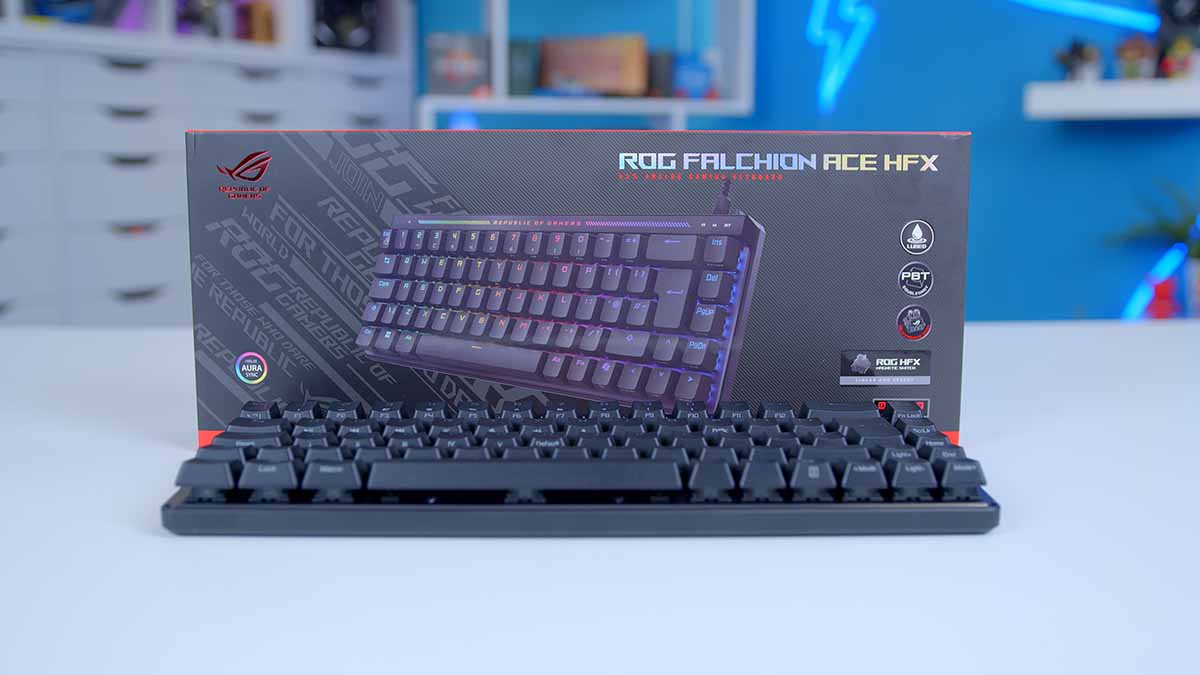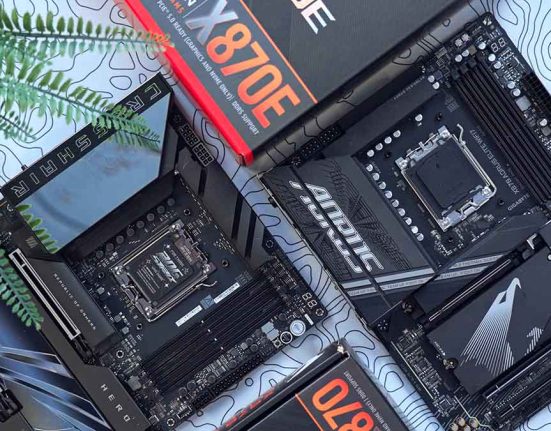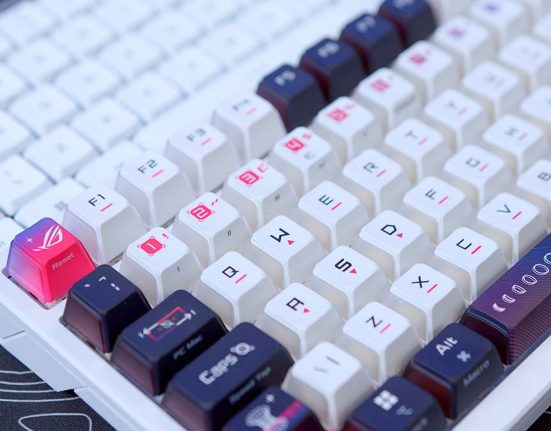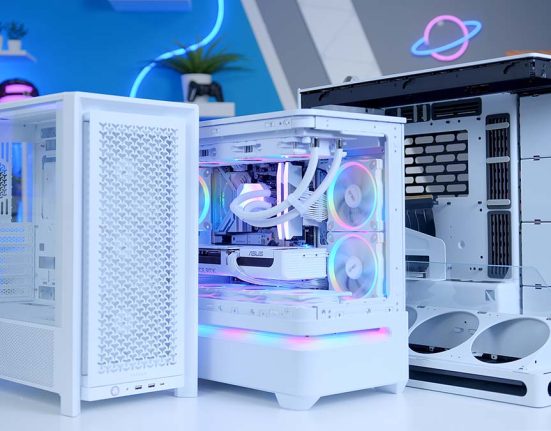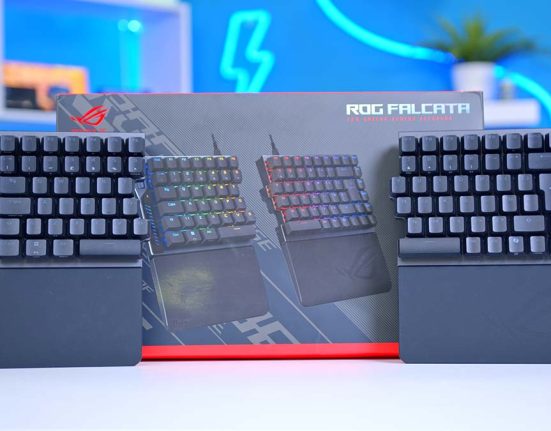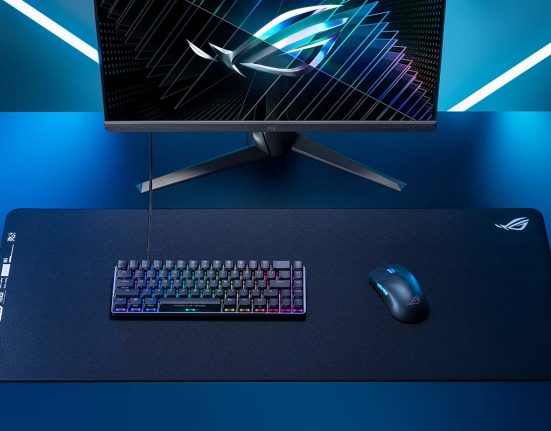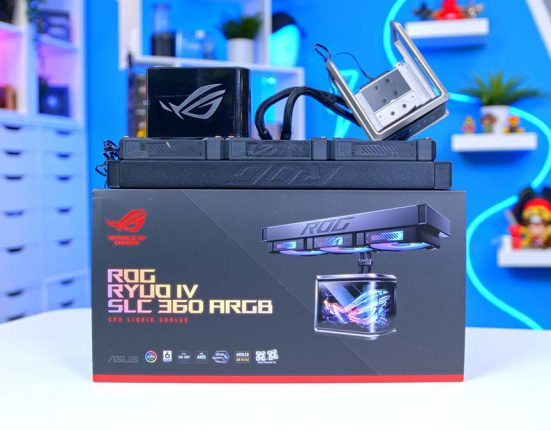The ASUS ROG Falchion Ace HFX is a unique mechanical keyboard with rapid-fire magnetic switches. It is designed to offer accurate and speedy inputs, giving you the edge in competitive titles. The magnetic switches also allow for extensive customisation, as the actuation point of individual switches can be configured to match your preferences. To see how the ASUS ROG Falchion Ace HFX compares to other keyboards with magnetic switches, we’ve tested it rigorously over several days to see how it feels and performs.
One of the big caveats of Hall Effect switches is that changing the actuation point often fails to emulate the experience of physically replacing the switches. For this reason, magnetic switches often provide a lacklustre keyboard feel that lacks variation, even when the actuation is heavily modified. In this review, we’ve had a more in-depth look at the keyboard feel of the ROG Falchion Ace HFX to see how it compares to market alternatives with Hall Effect switches.
Per our keyboard reviews, this article examines the ROG Falchion Ace HFX’s specs, design, switches, keycaps, and features to determine its value.
Specification
ASUS’ ROG Falchion range are small form factor keyboards that ooze sophistication and modernity. However, the ROG Falchion Ace HFX is a particularly unique offering from ASUS, as it is one of their first magnetic switch options. With a 65% layout of 70 keys, the ROG Falchion Ace HFX is compact and can be quickly taken on the go. The 65% layout reduces the number of navigation keys towards the right side of the keyboard but maintains a set of arrow keys and a dedicated number row to enjoy the functionality of a larger keyboard.
For keycap choices, prospective buyers can pick Double-Shot PBT, a grittier but more durable plastic offering more grip but no fancy colours. The other option is ROG UV-coated ABS plastic keycaps, which are resistant to shine because they use a coating layer that provides better abrasion. Note that the materials used for the keycaps depend on the region and are not options that can be selected before purchase.

Regarding key rollover, as you can expect, the ROG Falchion Ace HFX features NKRO (n-key rollover), which means every input is registered when pressed in a specific order, and the anti-ghosting ensures multiple inputs are registered at once.
Connectivity options are slightly more restrictive compared to other ASUS keyboards we’ve reviewed in the past. The ROG Falchion Ace HFX is wired-only, with no 2.4GHz or Bluetooth compatibility. However, two USB Type-C ports are on the rear of the keyboard, allowing you to switch between multiple devices, a feature we’ll touch on later. Limiting the ROG Falchion Ace HFX to wired means the report rate is generally higher, which ASUS claim this keyboard can respond within 0.125ms thanks to the 8000Hz report rate. The RGB lighting is also fully customisable through ASUS Armoury Crate software.
| Specifications | ASUS ROG Falchion Ace HFX |
|---|---|
| Size | 65% (70 keys) |
| Keycap Material | Double-Shot PBT UV-Coated ABS |
| Switches | ROG HFX Magnetic |
| Key Rollover | Full Key (NKRO), 100% Anti-Ghosting |
| Macro Keys | All Keys Fully Programmable |
| Connectivity | Wired |
| Report Rate | 8000Hz |
| RGB | Yes |
On the pricing front, the ROG Falchion Ace HFX is currently $199.99. This puts it above other magnetic switch keyboards like the Endgame Gear KB65HE but slightly under the K70 MAX, which offers similar features. I don’t think $199.99 is an unreasonable ask, but it depends entirely on the feel of this keyboard and the features that will make it stand out from the rest of the market.
ASUS ROG Falchion Ace HFX Design
Like the ROG Falchion RX Low Profile, the Ace HFX is a sophisticated keyboard. It features a streamlined, compact, primarily plastic chassis. It isn’t as striking as the Falchion RX Low Profile, but the minimalist black aesthetic works well with a darker-themed setup. The outer housing is made of smooth black plastic, while the top plate looks to be a much firmer aluminium, providing rigidity and stability to the keyboard.

The ROG Falchion Ace HFX weighs 643g without the cable and generally feels very lightweight, making it easy to carry around. There is a small amount of deck flex when pressing down towards the centre of the keyboard, but nothing alarming. You would have to apply a fair amount of pressure to cause any damage to the PCB, and the rigidity of the top plate prevents this.
The ROG Falchion Ace HFX’s back features a slightly ridged design that helps the keyboard maintain grip on a flat surface. The keyboard also has a set of kickstands. These kickstands have two adjustable height levels, which can improve your typing experience. I use the first level, as the angle doesn’t feel as harsh as the top kickstand height.

I will say that after using the ROG Falchion Ace HFX, the design feels noticeably cheaper than the ROG Falchion RX Low Profile. The design elements, such as the plastic chassis and the typical black colour scheme, don’t look as good. However, we imagine ASUS made some sacrifices to the aesthetic so that more could be spent on the features of this keyboard. That being said, I don’t think the ROG Falchion Ace HFX is designed poorly at all, but it looks and feels cheaper compared to other ASUS peripherals we’ve looked at previously.
All keys on the ROG Falchion Ace HFX feature fully programmable RGB lighting. This is configured within Armoury Crate software, which was easy to change after a software update. The illumination shines brightly through the keycaps, and the brightness and effects can be adjusted with minimal hassle.

The touch bar has returned to the ROG Falchion Ace HFX. I was a massive fan of this feature on the ROG Falchion RX Low Profile, so seeing it reappear on the magnetic-switch version is great. The touch bar looks incredibly sleek and offers a unique way of displaying information while adding practicality to the keyboard.
The settings of the touch bar are controlled by a button towards the top left of the keyboard and a slider just next to it. The button changes the mode, which allows you to amend brightness and media playback, change the actuation point of the switches, or add a macro. The slider then controls the strength or elements of these settings. There’s also plenty of RGB on the touch bar, which looks excellent.

The ROG Falchion Ace HFX arrives in a protective dust cover that acts as a small bag for the keyboard. Additionally, ASUS provides a plastic protective cover that doubles as a tray mount for those working on a train or plane.

Regarding the layout, this keyboard utilises a 65% form factor with 70 programmable keys. This form factor has become incredibly common over the past couple of years, as small form factor keyboards are generally better for gamers and typists. There are upsides and downsides to 65% keyboards. Because they’re compact, they are easier to carry around, making them ideal for those on the go often.
However, they lack some keys that some prospective buyers may find helpful. There’s no dedicated function row; these keys are combined with the number keys and ‘Fn’ to access them. Some unit sizes have also decreased (unit size means the size of the key). The left shift is a 1.25U key, and the right shift is 1.75U, considerably smaller than larger keyboards.

At the top of the keyboard, you’ll find the dual USB Type-C ports, the touch bar slider and button, the toggle for the left and right USB ports, and a rapid trigger switch. It is a shame that this keyboard doesn’t offer wireless connectivity. However, the dual USB Type-C ports provide value for those with multiple devices.

Keycaps and Switches
The ROG Falchion Ace HFX switches are one of this keyboard’s more exciting features. HFX switches (or Hall-Effect switches) are similar to traditional linear mechanical switches in that they have identical top and bottom housing and stems that offer compatibility with a massive variety of keycaps. However, these switches are activated by a magnetic field instead of physical contact, which means resistance can be increased to change the travel distance of the switches.

More keyboard manufacturers have started using Hall Effect switches because they offer more longevity than traditional switches, as there are no physical pins that scratch to make contact. The ROG HFX switches in this keyboard offer an actuation distance from 0.1mm up to 4mm, which is standard.
I’m a big fan of higher actuation, as it reduces the number of accidental keypresses and provides a more well-rounded feel. Overall, I think the ASUS ROG HFX switches are well-built. When increased, actuation feels much more potent, making typing more enjoyable. Because the switches are also linear, they have an excellent ‘thock’ sound when they bottom out.

It’s also worth highlighting that all switches are pre-lubed and have a walled stem. Pre-lubing the switches makes them incredibly smooth, so they bottom out virtually without resistance. Walling the stems also reduces keycap wobble, which is a nice touch if you’re a fast typist. ASUS also use five-layer dampening and a gasket mount to absorb vibrations, resulting in an incredibly smooth typing experience.
Actuation Points
I tested the ROG Falchion Ace HFX at three different actuation points, starting at 1mm, then 2.5mm and 4mm. Unfortunately, the typing experience isn’t great when the actuation point is higher. At 1mm, you must press down very lightly, or the keys respond twice, making typing quite challenging. At 2.5mm, typing was more viable, but for a linear switch, the actuation just felt too light. If this were a clicky switch, you’d get the feedback around 2.2mm, which is better, but linear switches almost need to bottom out.
At 4mm, this is when the ROG Falchion Ace HFX was at its strongest. When typing on a keyboard with linear mechanical switches, the only feedback response is when the switch can no longer move and has bottomed out. This also minimises fatigue, as even on lighter switches with a lower actuation, it’s generally much easier for the switch stem to hit the bottom of the shaft. I think the lower actuation works well for gaming, but it’s much better to stick to the higher actuation for typing.
Keycaps
The keycaps are not particularly special. ASUS uses Double-Shot PBT across most of its keyboards, and this is what we have on the UK variant. However, in some regions, ASUS offers UV-coated ABS plastic, which we saw on the ROG Falchion RX Low Profile. The Double-Shot PBT plastic offers a nice grit feel, which improves grip. They’re also hollowed out towards the top, allowing RGB to shine through easily.

The main benefit of Double-Shot PBT is that it’s incredibly resistant. It lasts for years, and the legend doesn’t wear out over time because it’s injected into the plastic. It’s good to see the use of long-lasting materials, and it feels great on the fingers.
My one qualm is that seeing some alternative keycap profiles would be nice. The keycap profile on the ROG Falchion Ace HFX is a typical Cherry, but this keyboard would offer a stronger value proposition if there were other options like XDA or DSA.
Features We Like
Versatile Touch Bar
The touch bar on the ROG Falchion HFX is a returning feature from the ROG Falchion RX Low Profile, which we’ve reviewed previously. It offers a unique look to the keyboard but also provides plenty of versatility and functionality, allowing you to change a range of settings on the fly easily.

Dual USB-C Connectivity
One of this keyboard’s more unique features is its dual USB-C ports. A toggle on the keyboard switches between ports one and two, which is particularly handy for those with a multiple-device setup. You can easily control both machines by flipping the switch.

Simple Software
After installing software and firmware updates, the Armoury Crate application allowed me to configure the keyboard settings and change the RGB lighting easily. The ROG Falchion Ace HFX has various customisable features that can be quickly changed within Armoury Crate.
Features We Don’t Like
Rapid Trigger & Speed Tap
Unfortunately, the rapid trigger and speed tap modes are the most significant weaknesses of this keyboard, not because of how they work but because of their implications. Essentially, the rapid trigger toggle at the top of the keyboard, when activated, makes the magnetic switch instantly reset as it moves upwards, maximising speed and strafing potential in a game.
Combined with the speed tap mode, which allows a gamer to continue moving even when two opposing directional keys are pressed, you’re effectively automating strafing. The implication is that it may result in you getting banned from your favourite game.

Valve announced days before the ROG Falchion Ace HFX was released that any “players suspected of automating multiple player actions from a single game input may be kicked from their match”. This is in reference to Counter-Strike 2. There’s plenty of controversy surrounding this feature in various Esports communities, as it crosses the line of what most would consider cheating. While this may offer a competitive advantage, we don’t believe it’s worth being banned over.
No Wireless Connectivity
It’s a shame that this keyboard, which costs nearly $200, can only be connected through USB-C. It would be great to see 2.4GHz compatibility or Bluetooth connectivity to make the ROG Falchion Ace HFX easier to use on the go.

Conclusion
ASUS ROG Falchion Ace HFX
Product Name: ROG Falchion Ace HFX
Brand: ASUS
-
Features
-
Design
-
Versatility
-
Value For Money
Summary
The ASUS ROG Falchion Ace HFX keyboard is a 65% mechanical design with highly customisable magnetic switches. Typing feels incredibly refined, smooth, and fast, and the adjustable actuation, easily customised within Armory Crate, allows gamers to find the right typing feel. This keyboard’s overarching design and aesthetic are excellent. While the ROG Falchion Ace HFX does feel somewhat cheaper compared to the ROG Falchion RX Low Profile, many qualities make this keyboard look great, such as the touch bar and vibrant RGB lighting. If you’re looking for a keyboard that offers a massively customisable typing and gaming experience, the ROG Falchion Ace HFX is worth considering.
However, my biggest qualm with this keyboard comes down to the Rapid Trigger and Speed Tap settings that ASUS advertise as one of its main USPs (unique selling points). Speed Tap is considered cheating and will result in kicks and potential bans within Counter-Strike 2. This is the only game thus far that has announced an outright ban on this hardware, but we may see future game developers introduce more blanket bans across keyboards that allow you to swap and continue inputs with no delay. Aside from this, I think the ROG Falchion Ace HFX is well-built and a strong competitor despite the risk some of its hardware poses within certain Esports games.
Pros
✅ Smooth typing experience
✅ Customisable actuation
✅ Dual USB C ports
Cons
❌ Speed Tap considered cheating
❌ No wireless connectivity
❌ Feels cheaper


